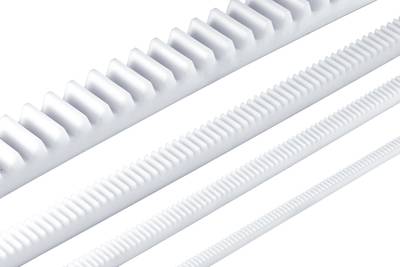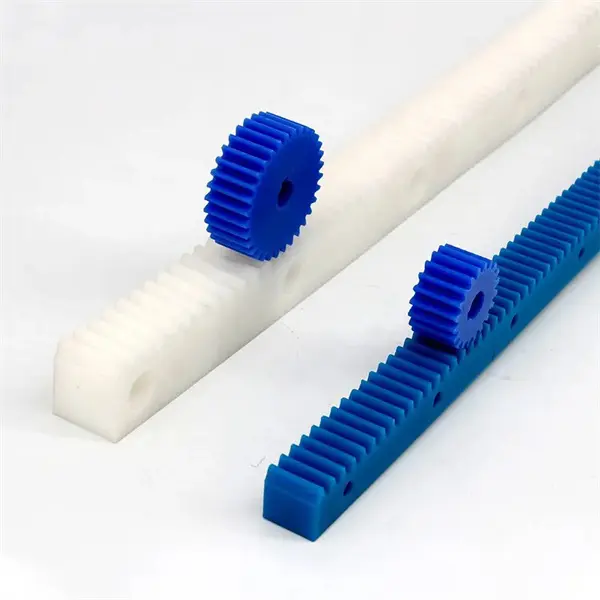Product Description
Product Description
Gear rack & pinion in modulus M1 M1.5 M2 M2.5 M3 M4 M5 M6 M8
| Product Name |
Gear Rack & Pinion |
| Modulus | M1, M1.5, M2, M2.5, M3, M4, M5, M6, M8 |
| Length | 500mm/1000mm/2000mm/3000mm |
|
Material |
Stainless steel SS304 ,Carbon steel C45, Aluminum , Nylon PA6 ect |
|
Treatment |
Black oxide, Electrogavanized, Teeth indutive hardened |
|
Hardness |
HRC 40-55 after teeth inductive hardened |
| Standard |
DIN, ANSI, JIS, BS, ISO |
|
Grade |
6 , 7 , 8, 9 |
| TYPE NO. | TYPE NO. |
|
M1 15X15X1000 |
M4 40X40X1000 |
| M1 15X15X2000 | M4 40X40X2000 |
| M1.5 17X17X1000 | M4 40X40X3000 |
| M1.5 17X17X2000 | M5 50X50X1000 |
| M2 20X20X1000 | M5 50X50X2000 |
| M2 20X20X2000 | M5 50X50X3000 |
| M2 20X20X3000 | M6 60X60X1000 |
| M2.5 25X25X1000 | M6 60X60X2000 |
| M2.5 25X25X2000 | M6 60X60X3000 |
| M2.5 25X25X3000 | M8 80X80X1000 |
| M3 30X30X1000 | M8 80X80X2000 |
| M3 30X30X2000 | M8 80X80X3000 |
| M3 30X30X3000 |
Detailed Photos
Catalogue
Workshop
Milling teeh Inspecting teeth
Packaging & Shipping
FAQ
Q1: Are you trading company or manufacturer ?
A: We are factory.
Q2: How long is your delivery time and shipment?
1.Sample Lead-times: 10-20 days.
2.Production Lead-times: 30-45 days after order confirmed.
Q3: What is your advantages?
1. The most competitive price and good quality.
2. Perfect technical engineers give you the best support.
3. OEM is available.
| Application: | Motor, Machinery, Agricultural Machinery |
|---|---|
| Hardness: | Hardened Tooth Surface |
| Toothed Portion Shape: | Spur Gear |
| Modulus: | M1 M1.5 M2 M2.5 M3 M4 M5 M6 M8 |
| Length: | 500mm/1000mm/2000mm/3000mm |
| Origin: | Zhejiang |
| Customization: |
Available
| Customized Request |
|---|

Can rack and pinion mechanisms be customized for specific machinery and equipment?
Yes, rack and pinion mechanisms can be customized to suit specific machinery and equipment requirements. Here’s a detailed explanation of how rack and pinion systems can be customized:
- Size and Dimensions: Rack and pinion systems can be customized in terms of their size and dimensions to fit the available space and integration requirements of the machinery or equipment. The length, width, and height of the rack can be adjusted, and the pinion gear size can be modified to ensure proper fit and compatibility.
- Materials: The choice of materials for the rack and pinion components can be customized based on factors such as load capacity, environmental conditions, and specific application requirements. Different materials, such as steel, stainless steel, aluminum, or various alloys, can be selected to optimize strength, durability, corrosion resistance, and other desired properties.
- Teeth Profile: The tooth profile of the rack and pinion gears can be customized to meet specific application needs. Different tooth profiles, such as straight, helical, or even custom-designed profiles, can be utilized to enhance load distribution, reduce noise, increase contact area, or improve efficiency based on the unique requirements of the machinery or equipment.
- Precision and Tolerance: The precision and tolerance levels of rack and pinion systems can be customized to achieve the desired level of accuracy and motion control. Tighter tolerances can be specified to enhance positioning and repeatability, while looser tolerances may be suitable for applications that prioritize cost-effectiveness over extreme precision.
- Mounting Options: Rack and pinion systems can be customized to offer various mounting options to facilitate integration with specific machinery or equipment. Mounting holes, brackets, or specific attachment mechanisms can be incorporated into the design to ensure proper alignment, stability, and ease of installation.
- Accessories and Features: Customized rack and pinion systems can include additional accessories or features to enhance functionality and application-specific requirements. This can include the incorporation of sensors, limit switches, lubrication systems, protective covers, or any other components that are necessary for the proper operation and maintenance of the machinery or equipment.
- Integration with Control Systems: Rack and pinion systems can be customized to integrate seamlessly with the control systems of the machinery or equipment. This allows for synchronization, feedback control, and coordination with other system components, enabling precise motion control and automation in line with specific application needs.
By considering factors such as size, dimensions, materials, tooth profile, precision, mounting options, accessories, and integration with control systems, rack and pinion mechanisms can be effectively customized to meet the unique requirements of different machinery and equipment. Customization ensures optimal performance, reliability, and compatibility, allowing rack and pinion systems to be tailored for specific applications across various industries.

How do rack and pinion systems fit into the design of material handling equipment?
Rack and pinion systems play a crucial role in the design of material handling equipment, providing efficient and precise motion control for various handling tasks. Here’s a detailed explanation of how rack and pinion systems fit into the design of material handling equipment:
Rack and pinion systems offer several advantages that make them well-suited for material handling applications:
- Precision and Accuracy: Rack and pinion systems provide precise and accurate motion control, allowing for precise positioning and movement of materials. The direct engagement between the pinion and the rack ensures a positive and backlash-free transfer of motion, enabling precise and repeatable handling operations. This precision is essential in material handling equipment, where accurate placement and alignment of objects are critical.
- High Load Capacity: Rack and pinion systems can handle substantial loads while maintaining efficient power transmission. The engagement of the teeth provides a large contact area, allowing for the effective distribution of forces and torque. This load-handling capability is crucial in material handling equipment, where the system needs to lift, move, and transport heavy objects or loads.
- High Speed and Acceleration: Rack and pinion systems can accommodate high-speed movements and rapid accelerations, enabling efficient material handling operations. The direct power transmission and efficient torque transfer of rack and pinion mechanisms allow for quick and dynamic movements, reducing cycle times and improving overall productivity. This characteristic is advantageous in material handling equipment that requires fast and agile motion.
- Compact Design: Rack and pinion systems offer a compact design, which is beneficial in material handling equipment with limited space. The linear nature of the rack allows for efficient integration into the equipment’s structure, optimizing the use of available space. This compact design is particularly valuable in confined areas or when multiple axes of motion need to be incorporated into the equipment.
- Versatility: Rack and pinion systems offer versatility in material handling equipment design. They can be implemented in various orientations, such as horizontal, vertical, or inclined setups, to accommodate different handling requirements. Additionally, rack and pinion systems can be combined with other mechanisms, such as belts, chains, or gears, to achieve complex motion profiles and multi-axis control, enhancing the versatility of material handling equipment.
- Reliability and Durability: Rack and pinion systems are known for their durability and long service life. When properly designed and maintained, they can withstand the demands of continuous operation, repetitive movements, and heavy loads. This reliability is crucial in material handling equipment, where uptime, robustness, and consistent performance are essential.
In the design of material handling equipment, rack and pinion systems are commonly used in various applications, including conveyor systems, gantry cranes, lifting platforms, automated storage and retrieval systems (ASRS), and robotic arms. They facilitate precise and efficient handling of materials, optimizing productivity, and ensuring smooth operations in industries such as logistics, manufacturing, warehousing, and distribution.

What is a rack and pinion system, and how does it function?
A rack and pinion system is a type of mechanical mechanism used to convert rotational motion into linear motion. It consists of two primary components: a rack and a pinion gear. Here’s a detailed explanation of how it functions:
The rack is a straight bar with teeth cut along its length, resembling a gear but in a linear form. The pinion gear, on the other hand, is a small circular gear with teeth that mesh with the teeth on the rack. The pinion gear is typically mounted on a rotating shaft, while the rack remains stationary or moves linearly.
When rotational force is applied to the pinion gear, it rotates, causing the teeth on the pinion to engage with the teeth on the rack. As the pinion gear turns, its teeth push against the teeth on the rack, causing the rack to move linearly in response to the rotational motion of the pinion gear.
The linear motion of the rack can be utilized for various purposes, depending on the specific application. In the context of steering systems in vehicles, for example, the rack is connected to the steering column, and the linear motion of the rack is used to steer the front wheels. When the driver turns the steering wheel, the rotational motion is transferred to the pinion gear, which then moves the rack in a linear manner. This linear motion of the rack translates into the lateral movement of the wheels, allowing the vehicle to change direction.
The meshing of the teeth on the pinion gear and the rack ensures a direct and precise mechanical connection. The close engagement between the teeth minimizes any play or backlash, resulting in accurate and responsive motion. The design of the teeth and the gear ratio between the rack and pinion can be optimized to balance the desired motion, force, and speed requirements for a specific application.
Rack and pinion systems find application in various fields, including automotive steering, robotics, automation, and machinery. They offer advantages such as compactness, efficiency, reliability, and precise motion control, making them a popular choice for converting rotational motion into linear motion in a wide range of mechanical systems.


editor by CX 2023-11-29